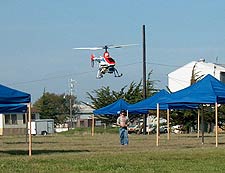Berkeleyan
Research Roundup
![]()
12 January 2005
Low-altitude robo-copters can avoid obstacles, readjust course
Members of the Berkeley Aerial Robot (BEAR) program have successfully conducted a series of field tests with 130-pound helicopters that not only fly autonomously — without human control — but also react to avoid obstacles in their flight path.
“Our BEAR group is the first to successfully develop a system where autonomous helicopters can detect obstacles, stationary or moving, and recompute their course in real time to reach the original target destination,” said research engineer David Hyunchul Shim.
 An unpiloted 'robo-copter' on one of several test runs at the campus's Richmond Field Station. (UC Berkeley photo) |
The development of reliable systems that can handle obstacle-avoidance tasks is still several years away, researchers said, but the computational foundations for such unmanned aerial vehicles (UAVs) have been laid.
In 2003, the Defense Advanced Research Projects Agency began funding specific research on obstacle avoidance as part of the agency’s Unmanned Combat Armed Rotorcraft (UCAR) program, which aims to integrate autonomous helicopters in combat and reconnaissance missions. This research into avoiding unknown obstacles, a field called nonlinear model predictive control (MPC), is one of several UAV projects in the BEAR group.
The Berkeley researchers also see significant potential for civilian applications, such as for automated search-and-rescue missions, inspections of power lines and pipelines, or fighting wildfires. The helicopters could also be used to carry thermal-imaging equipment used in agriculture to detect pest infestations.
— Sarah Yang
‘Blind’ cells see the light
A team of Berkeley scientists has given “blind” nerve cells the ability to detect light, paving the way for an innovative therapy that could restore sight to those who have lost it through disease.
The team, led by neurobiologist Richard Kramer, a professor of molecular and cell biology, and Dirk Trauner, assistant professor of chemistry, inserted a light-activated switch into brain cells normally in-sensitive to light, enabling the researchers to turn the cells on with green light and turn them off with ultraviolet light.
This trick could potentially help those who have lost the light-sensitive rods and cones in their eyes because of nerve damage or diseases such as retinitis pigmentosa or age-related macular degeneration. In these cases, the photoreceptor cells are dead, but other nerve cells downstream of the photoreceptors are still alive. In particular, retinal ganglion cells, which are the third cell in the path from photoreceptor to brain, could take over some of the functions of the photoreceptors if they could be genetically engineered to respond to light.
Kramer envisions a device, reminiscent of the eyepiece worn by the blind Geordi La Forge in Star Trek: The Next Generation, that would provide some semblance of the real world.
“We may be able to use laser scanning to trace on and off patterns on the retina and allow people to see visual patterns,” Kramer said. “Sometimes I’m not sure where the science ends and the fantasy begins, but I think we can make it work.”
“With this technique, you also could confer light sensitivity on organisms that normally don’t have vision, such as the nematode worm C. elegans,” Trauner said. “Taking this from a chemical novelty to showing that it works in a biological system is a real breakthrough.”
Kramer, Trauner, and their colleagues reported their results recently in a paper published online in the journal Nature Neuroscience.
— Robert Sanders
Hummingbirds pay a price for elevation gain
Researchers from Berkeley and the California Institute of Technology have demonstrated a clear decline in hummingbirds’ lifting ability with altitude, not unlike that seen in athletes competing at high elevations. This means the birds have less power in reserve for the bursts of flight they need to chase off competitors or escape from predators.
The researchers set out to answer some puzzling questions about hummingbird flight, which is among the most power-hungry activities of any animal, bird or otherwise. It had previously been shown that hummingbirds living at higher elevations have larger wings relative to their weight, presumably to create more lift in the thinner air. Further experiments showed that hummers sweep their wings through a bigger angle (a.k.a. the “stroke amplitude”) to compensate further.
With full data from 347 of nearly 1,000 captured hummingbirds, a sample representing 43 species, study leader Douglas Altshuler was able to show that, whereas a hummingbird’s body mass and power output increase with elevation, the power margin goes down.
“The costs of hovering flight are the same across elevations because hummingbirds compensate by having larger wings and a larger stroke amplitude,” said Altshuler, a postdoctoral fellow at Caltech. “However, that compensation doesn’t come for free. They don’t have as much excess power at high elevations as they do at low elevations.”
“The power margin decreases at higher elevation, primarily because the stroke amplitude of the wing increases to account for the thinner air,” added co-author Robert Dudley, a professor of integrative biology at Berkeley. “If the bird can only flex its wings through a maximum of 180 degrees, that leaves less power available for other things, like ascending and chasing.”
Altshuler noted that the many quick movements hummingbirds make would be impaired by a loss of marginal power at high elevations. That loss of power and maneuverability at higher elevations affects their social interactions and determines which of them dominates the flower territory.
— Robert Sanders

